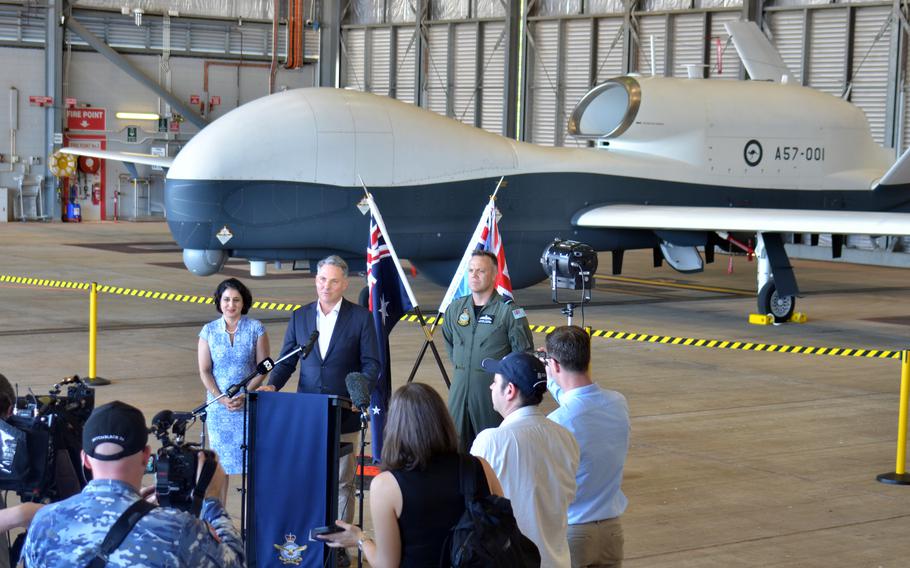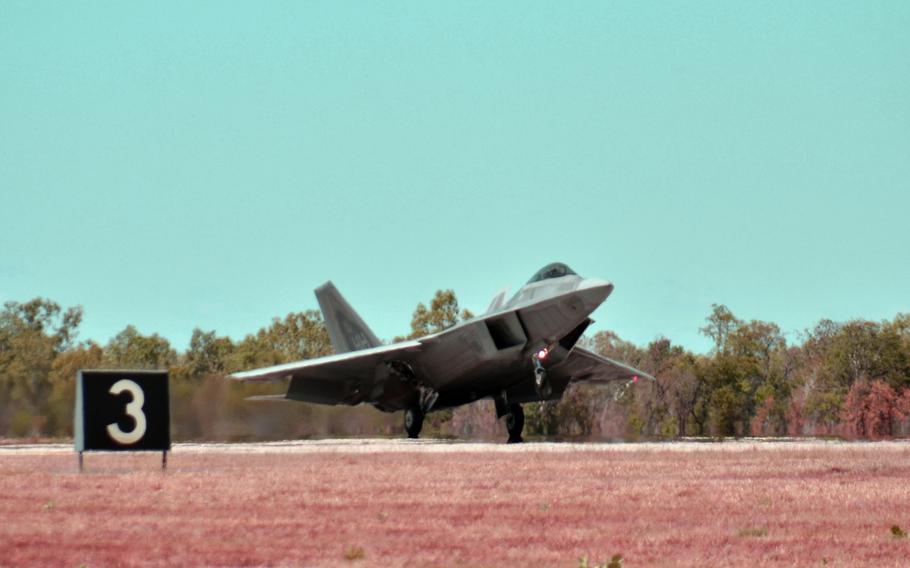
The first of four MQ-4C Tritons being added to Australia’s arsenal debuts at Royal Australian Air Force Base Tindal, Wednesday, July 31, 2024. (Seth Robson/Stars and Stripes)
ROYAL AUSTRALIAN AIR FORCE BASE TINDAL, Australia — Deep in the outback, a flurry of construction by Australia and the United States is transforming this once quiet military installation into a potential launchpad in case of conflict with China.
Runways are being expanded and strengthened to accommodate the allies’ biggest airplanes, including American B-52 bombers. A pair of massive fuel depots is rising side by side to supply U.S. and Australian fighter jets. And two earth-covered bunkers have been built for U.S. munitions.
But the activity at RAAF Tindal, less than 2,000 miles from the emerging flash points of the South China Sea, isn’t unique. Across Australia, decades-old facilities — many built by the United States during World War II - are now being dusted off or upgraded amid growing fears of another global conflict.
“This is about deterrence,” Australia’s defense minister, Richard Marles, said in an interview. “We’re working together to deter future conflict and to provide for the collective security of the region in which we live.”
The United States has ramped up defense ties with allies across the region, including with the Philippines and Japan, as it tries to fend off an increasingly assertive and aggressive China. Australia offers the United States a stable and friendly government, a small but capable military and a vast expanse from which to stage or resupply military efforts.
U.S. Secretary of Defense Lloyd Austin, hailing the “the extraordinary strength of our unbreakable alliance with Australia,” said after a meeting with Marles earlier this month that deeper cooperation — including base upgrades and more frequent rotational bomber deployments — would help build “greater peace, stability, and deterrence across the region.”
Australia has also joined the AUKUS agreement, under which the United States and Britain will provide it with nuclear-propelled submarines, some of the world’s most closely guarded technology.
These moves underscore a bigger shift, as Canberra has grown increasingly tight with Washington as they both grow wary of Beijing. Military cooperation has become so extensive that critics quip Australia is becoming the United States’ “51st state.”
Mihai Sora, a former Australian diplomat who is an analyst at the Lowy Institute, a Sydney think tank, has a different metaphor. Australia is “an unsinkable aircraft carrier right at the bottom of the critical maritime sea lanes.”
“As the stakes increase in the South China Sea, as the risk over conflict in Taiwan increases, northern Australia in particular becomes of increasing strategic value for the United States,” Sora said.
American representatives on a recent congressional delegation to Darwin, on Australia’s northern coast, agreed.
“This provides a central base of operations from which to project power,” Rep. Michael McCaul (R-Tex.), chairman of the House Foreign Affairs Committee, said during the trip.
Some Australian experts, however, argue that the growing U.S. military footprint doesn’t deter conflict with China so much as ensure Australia will be involved.
“I have deep misgivings about the whole enterprise” of increased U.S. military activity in Australia, said Sam Roggeveen, a former Australian intelligence analyst who is also at the Lowy Institute. “It conflates America’s strategic objectives in Asia with ours, and it makes those bases a target.”
Australia’s center-left government inherited AUKUS from a previous conservative administration, but it has embraced the agreement and the broader idea of enhanced U.S.-Australia military cooperation. Still, some critics have accused it of moving too cautiously.
“We need the current plans times 10,” said Peter Jennings, a former senior defense official who has urged Australia’s military to make rapid changes to deter a conflict with China. “The direction is right, but what it needs now is money and serious political effort.”

Australian Deputy Prime Minister Richard Marles, flanked by Northrop Grumman Australia chief executive Christine Zeitz and the head of nation's air force, Air Marshal Stephen Chappell, speaks about new MQ-4C Tritons at Royal Australian Air Force Base Tindal, Wednesday, July 31, 2024. (Seth Robson/Stars and Stripes)
Catching China’s attention
Australia has been rattled by a decade of growing Chinese military assertiveness in the region. But Beijing’s recent trade war on Canberra and a Chinese security agreement with Australia’s neighbor the Solomon Islands have accelerated Australia’s tilt away from its biggest trading partner and toward the United States.
Australia has spent roughly $1 billion on upgrading the Tindal air force base. Built by U.S. Army engineers in 1942 to stage bombing raids on Japanese targets in Papua New Guinea and Indonesia, Tindal is now the site of dozens of construction projects. A key one is the new parking apron capable of accommodating four of Australia’s biggest planes: KC-30 tankers that can refuel fighter jets and allow for far more distant attacks.
But there are also plans for the United States to build its own parking apron here, big enough for six B-52 bombers capable of reaching mainland China.
“That is absolutely something China would pay attention to,” said Roggeveen.
Marles declined to comment on the increasing rotations mentioned by Austin, but said the trajectory is “an increasing American force posture in Australia.” “We see that as very much in Australia’s national interest,” he said. “People understand that we are living through challenging times, when the global rules-based order is under pressure.”
Darwin, 200 miles north of Tindal, was heavily bombed by Japan during World War II. It has hosted six-month rotations of U.S. Marines since 2012, but what began as a training mission has evolved into a much larger enterprise.
The United States recently built a new fuel depot for the Marines’ MV-22 Ospreys, tilt-rotor aircraft that can take off and land vertically like a helicopter but can transition midair to fly like an airplane. The United States is planning to expand the parking apron here, too, to enable more Osprey operations.
A map provided to the visiting U.S. congressional delegation showed how midair refueling could extend the Ospreys’ range into the South China Sea, the Philippine Sea and to the Solomon Islands.
“As Chairman Xi [Jinping] is looking out at all of this, he’s feeling more deterrence,” McCaul said, pointing to the map. “Our capabilities to respond are getting stronger.”
Australia is also surveying three “bare bases” - skeleton facilities in remote parts of Western Australia and Queensland - with an eye to upgrading them so heavier Australian and American airplanes can use them, said Brigadier Michael Say, who leads Australia’s Force Posture Initiative. He said it’s still being determined whether the United States will pay for some of the improvements.
In the Cocos Islands, tiny coral atolls in the Indian Ocean northwest of the Australian continent and just south of Indonesia, Canberra will soon begin upgrading the airstrip to accommodate heavier military aircraft, including the P-8A Poseidon, a “submarine hunter” that could monitor increased Chinese naval activity in the area. A U.S. Navy construction contract published in June listed the Cocos as a possible project location, but Say said it hasn’t yet been decided whether the United States will contribute.

An F-22 Raptor fighter assigned to Joint Base Pearl Harbor-Hickam, Hawaii, lands at Royal Australian Air Force Base Tindal, Australia, on Sept. 1, 2022. (Seth Robson/Stars and Stripes)
Diversifying or redistributing?
These “bare bases,” which stretch for 3,000 miles from east to west, fit a new U.S. strategy of dispersing its forces to prevent China from delivering a knockout blow.
“If one location gets taken out, the U.S. can still project force, it can still replenish and resupply and reinforce its troops,” Sora said. “Australia is fundamental to that but is just one plank in America’s regional force posture.”
Roggeveen questioned, however, whether the United States is actually increasing its capabilities in the region or merely moving assets out of places like Guam, which are more immediately threatened by China’s improving missile capability. Under AUKUS, the United States will begin rotating up to four nuclear-powered submarines through Western Australia in 2027.
“It’s not at all clear to me if the [U.S.] Pacific Fleet is getting more submarines or if they are just being moved from existing commitments in Guam or Pearl Harbor,” Roggeveen said.
Commander Matthew Comer, a spokesperson for U.S. Indo-Pacific Command, said it was too early to say from where the submarines will come.
Even if the subs are moved from Pearl Harbor or San Diego, their rotation through Perth will be “significant strategically,” said Charles Edel, Australia chair at the Center for Strategic and International Studies in Washington. “We are pulling them closer in to where they are needed.”
Some concerns linger in Washington over Australia’s commitment, however. During the visit to Darwin, McCaul and other representatives asked about the 99-year lease a Chinese company holds over the port surrounding the Australian naval base. Australian officials said two reviews had found there wasn’t a security concern, and that in the case of a conflict the port could be nationalized.
“Australia relies on China for prosperity and on America for security,” Rep. Jimmy Panetta (D-Calif.) told The Washington Post. “That’s the balance they are playing.”